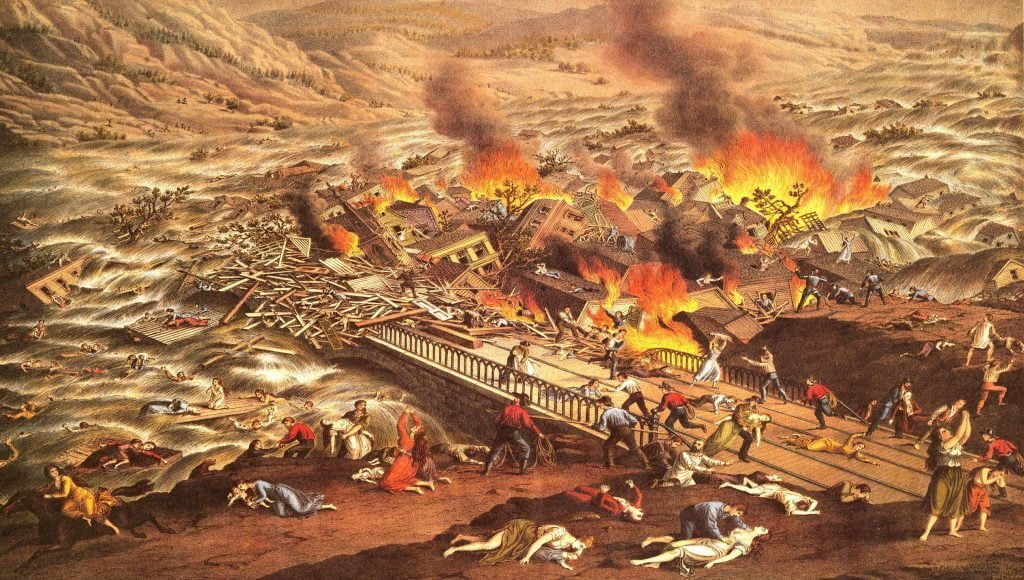
On May 28, 1889, a storm formed over Nebraska and Kansas, moving east. When the storm struck the Johnstown-South Fork area two days later it was the worst downpour that had ever been recorded in that section of the country. The US Signal Service estimated that 6 to 10 inches (150 to 250 mm) of rain fell in 24 hours over the entire section. During the night small creeks became roaring torrents ripping out trees and debris. Telegraph lines were downed and rail-lines were washed out. Before daybreak the Conemaugh River that ran through Johnstown was about to leave its banks.
During the day, things only got worse as water rose in the streets of Johnstown. Then, in the middle of the afternoon of May 31st, the South Fork Dam 14 miles (23 km) upstream burst, allowing the water formerly held back in the 3 mile (5 km) long Lake Conemaugh to cascade down the Little Conemaugh River.
When the wave reached the two-mile long oxbow in the river it split. Part of the wave left the river channel here, crossed the oxbow, and hit the 75-foot-high stone viaduct. Because the water was choked with debris by this time, it was temporarily dammed at the arch. The greater part of the flood followed the oxbow, and crashed into the viaduct six to seven minutes later. For a brief moment, the wreckage at the viaduct created a second dam for Lake Conemaugh. When the viaduct collapsed, it did so with even greater violence than the South Fork Dam.
The wave headed toward East Conemaugh. A witness said the water by now was almost obscured by the debris, resembling “a huge hill rolling over and over, “tossing up logs high above its surface. Before the flood hit East Conemaugh, train engineer John Hess tried to warn the residents by tying his train whistle down and racing toward town ahead of the wave. His warning saved many, but 50 people died, including about 25 passengers on trains that had been stranded in the town by earlier flooding caused by the rain.
The inhabitants of the town of Johnstown were caught by surprise as the wall of water bore down on the village, travelling at 40 miles per hour (64 km/h) and reaching a height of 60 feet (18 m) in places. Some, realizing the danger, tried to escape, but most people were hit by the surging flood water. Many people were crushed by pieces of debris, and others became caught in barbed wire from the wire factory upstream. For those that sought safety in attics, and for those that managed to stay aloft of the flood water on pieces of floating debris, the worst was to come, as they were forced to wait for hours for help to arrive.
At Johnstown, the Stone Bridge, which was a substantial arched structure, carried the Pennsylvania Railroad across the Conemaugh River. Some people who had been washed downstream became trapped in an inferno as debris that had piled up against the Stone Bridge caught fire, killing 80 people. The fire at the Stone Bridge burned for three days. After, the pile of debris there covered 30 acres (120,000 m²).
- Johnstown Flood Victims – List of Dead and Missing
List of dead and missing people in the Johnstown Pennsylvania Flood of 1889. - Johnstown Flood Mosaic Gallery of sketches
The following gallery represents over 60 sketches depicting the horrors of the flood. - The Johnstown Flood by Charles Guggenheim
Using archival film and photographs, this film recreates the history of the Johnstown flood which killed 2,200 people in 1889. From the development of the South Fork Hunting & Fishing Club on Lake Conemaugh to the assessment of the dam by members of the club and a concerned citizen of Johnstown to the disaster itself, this program includes the only extant photographs of life at the South Fork Hunting & Fishing Club on Lake Conemaugh during this time. - The Johnstown Flood History
- The Appalling News
- Death and Desolation
- The Horror Increases
- Multiplication of Terrors
- The Awful Work of Death
- Shadows of Despair
- Burial of the Victims
- Johnstown and Its Industries
- View of the Wreck
- Thrilling Experiences
- New Tales of Horror
- Pathetic Scenes
- Digging for the Dead
- Hairbreadth Escapes
- Terrible Pictures of Woe
- Stories of the Flood
- One Week After the Great Disaster
- A Walk Through the Valley of Death
- A Day of Work and Worship
- Millions of Money for Johnstown
Old news clip about the Johnstown Flood
There is some minor popping noise in the video. This is the type of film clip that would be shown before a picture show.
[box]Notes About Book and Database:
Source: Historical information was sourced from: The Johnstown Horror! or, Valley of Death, being A Complete and Thrilling Account of the Awful Floods and Their Appalling Ruin, by James Herbert Walker. Published by H. J. Smith & Co. 1889.
List of the Dead and Missing is sourced from the Johnstown Flood National Monument.
Video is from old Universal News Film.
Online Publication: The manuscript was scanned and then ocr’d. In depth proof reading has been done on this manuscript and it is free of errors. The punctuation and spelling from the original text have been faithfully preserved. Only obvious typographical errors have been corrected.[/box]


